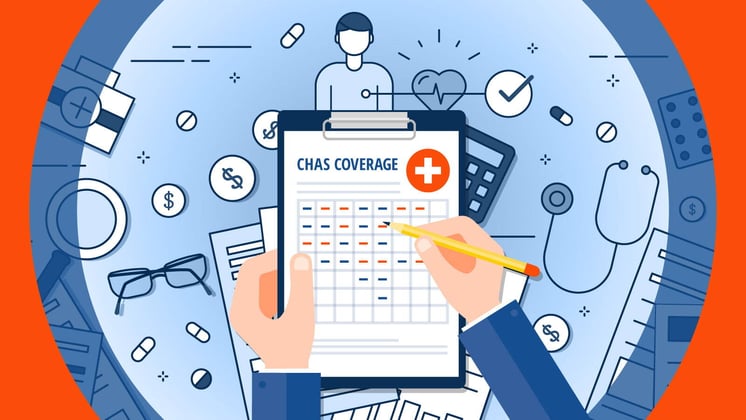
How to Replace Lost PDP Commissions: Add Ancillaries Like Cancer, Heart Attack and Stroke and Hospital Indemnity Insurance

With carriers lowering or removing commissions on so many Medicare health insurance and Part D Prescription Drug plans, insurance agents are trying to figure out how to make up for lost revenue. At the same time, many clients face significant premium hikes.
Is there a way for agents to replace lost income from Medicare plan commissions and also help clients save money on their Medicare health and drug insurance premiums?
Offering ancillary products can offset some of the lost income but should only be recommended when the solutions help the client save money and get needed coverage. Senior Market Sales® (SMS) has identified several creative solutions that involve bundling hospital indemnity or cancer, heart attack and stroke (CHAS) insurance plans with certain Medicare Advantage (MA), Medicare Advantage plus Part D (MA-PD) or Medicare Supplement plans — or both of these ancillary plans, in some cases.
One possible solution is to pair a high-deductible, low-premium MA or Med Supp plan with a hospital indemnity plan, for example. Because hospital indemnity plans pay a cash benefit to policyholders when hospitalized for a covered illness or injury, this concept is for the hospital indemnity plan to kick in upon hospitalization and offset the deductible amount.
The high-deductible Plan G Med Supp plan might be especially attractive for clients already in a standard Med Supp Plan G, as some are seeing double-digit premium increases for 2026 and already prefer Med Supp over MA because MA plans can limit provider choice and require prior authorizations. (The high-deductible Med Supp Plan G, which has been the fastest-growing Med Supp plan, has a deductible amount of $2,870 in 2025.)
“If you can reduce the premium by 20%, you’re going to make more sales,” said Dwane McFerrin, Senior Vice President, Med Solutions, at SMS. “This is a way for an agent to stand out, to save consumers money and to write business — and the first year or two of compensation is relatively equal. But most importantly, you’re helping people save money and find coverage that works for them.”
Several top agents who rely on SMS as their field marketing organization (FMO) have found notable success already with this strategy and are increasingly using CHAS insurance as another creative solution to counter high client premiums and low agent commissions, McFerrin said.
How Successful Agents Are Replacing Lost PDP Commissions
Joanne Giardini-Russell, CEO of Giardini Medicare, a family-operated Brighton, Michigan, insurance agency and SMS partner, packages hospital indemnity, CHAS and even short-term care with high-deductible, low-premium Med Supp Plan G plans to help shield clients from skyrocketing rate increases in standard Plan F and Plan G Medicare Supplement plans over time.
Some ancillary plans, such as hospital indemnity, can lock in a rate based on the age when a policy is purchased. Giardini-Russell said that in her experience, other ancillary plans like cancer and short-term care plans, simply haven’t seen the steep rate increases that standard Medicare Supplement plans have experienced. Her strategy is to shift the money that would go toward buying the ever-increasing Med Supp premiums to the more-stable premiums of ancillary products. If the standard Med Supp plan premium is similar to the net sum of the high-deductible Med Supp plus ancillaries’ premiums, you may be able to get your client more coverage for roughly the same amount of money.
To illustrate how this strategy has protected clients from premium hikes, she cited a real-life example of a 70-year-old male client with a high-deductible Med Supp Plan F compared to a similarly aged woman in a standard Plan G. While the male client’s monthly premium only rose from $51 in 2018 to $64 in 2025, the female client’s jumped from $140 in 2018 to $245.
The client gets extra coverage without the yearly rate increases of standard Med Supp and with the greater flexibility of Med Supp, Giardini-Russell said.
To further illustrate the strategy, she quoted a high-deductible Med Supp Plan G for a 65-year-old Michigan male.
| Example High-Deductible Med Supp Plan G for a 65-Year-Old Michigan Male | |
|---|---|
| Plan | Monthly premium |
| High-deductible Med Supp Plan G Projected 2026 deductible at time of quote: $2,950 |
$37 |
| Cancer $10,000, 3 years of maximum out-of-pocket |
$26.90 |
| Hospital indemnity $300/day for 10 days |
$19.99 |
| Short-term care $200/day for assisted living + $900 in cash for 13 weeks |
$49.28 |
| Total | $133.17 |
|
Lowest-cost standard Plan G in that area:
|
$125
|
| Pairing the high-deductible G with ancillary plans delivers more coverage for only an additional $8.17! | |
“You may be able to insulate the client from rate shock with their main Medicare plan year after year, so it’s a long-term win,” Giardini-Russell said. “And, if you can lock them into the ancillary coverages’ rates at 65 years old, the savings is even greater over time.”
Want to Package Ancillary Products With Med Supp Plans?
Some people may not like managing so many insurance plans, she said.
But, McFerrin said, some carriers offer auto-adjudication with some ancillary coverage claims.
How Does Auto-Adjudication Work With Medicare and Ancillary Plan Claims?
The process of auto-adjudication automatically processes and pays claims without the client having to collect medical records and submit their own claims. However, the ancillary plans may need to be with the same carrier as the Med Supp plan. That’s why it’s important for agents to know the plan details, McFerrin urged.
While auto-adjudication with hospital indemnity plans can remove the hassle of claim submissions, the automatic payment could create more hassles with a lump-sum cancer policy, for example. The policyholder might have to claw back the payment. However, the danger of a misdirected payment to a carrier may be moot if the carrier already solves for this by allowing the policyholder to select a payee at the time of claim, versus when the policy is sold.
“Agents will need to walk the consumer through the scenarios so they understand and can pick whether they prefer auto-adjudication, and if so, make sure they take the step of assigning payment elsewhere on the respective plans,” McFerrin said. “For day-to-day claims like those in hospital indemnity, they may want to have the payment assigned. But if they have a lump-sum cancer benefit and the primary reason they purchased it is they have a cancer history in their family, they may not want auto-adjudication because they need that money directly sent to them. Make sure the consumer is aware of the trade-off.”
Doing What’s Right for the Client … And Still Making a Living
As major carriers have made MA and PDP plans non-commissionable, most agents will continue to offer and service plans that they will earn little or no money on because it’s the right thing to do for the client. The same goes for offering ancillary coverages — you’ll want to recommend them only when it helps the client save money and obtain coverage that suits their needs.
But in those cases where ancillary plans can offer good coverage at affordable rates, expanding your portfolio to include them can indeed help you continue to get paid for helping your Medicare clients — and maybe make even more.
But first things first. Say you want to just break even.
How many CHAS plans would you need to sell to make up $10,000 of lost PDP revenue?
Using a CHAS plan with the bare minimum of a $5,000 benefit ($10,000 altogether) and a CHAS annual premium of $364.92, selling 50 policies would net $10,947 in potential first-year revenue. Second-year, street-level comp would be 60%; two to six years is 6%.
| Hypothetical Results of Replacing PDP Income With CHAS | |
|---|---|
| Policies sold: | Potential first year revenue*: |
| 100 policies | $21,895.20 |
| 50 policies | $10,947.50 |
| 33 policies | $7,218.75 |
| *Based on bare minimum of a $5,000 benefit ($10,000 altogether) and a CHAS annual premium of $364.92 | |
How many hospital indemnity plans would you need to sell to make up $10,000 in lost revenue?
To figure the answer, we used a plan with a benefit of six days in the hospital at $350 a day and a $10,000 first-diagnosis cancer rider. With that plan’s annual premium of $485.25, selling 50 policies would produce $13,345 of revenue.
| Hypothetical Results of Replacing PDP Income With Hospital Indemnity | |
|---|---|
| Policies sold: | Potential first year revenue*: |
| 100 policies | $26,690.40 |
| 50 policies | $13,345 |
| 33 policies | $8,807 |
| *Based on a benefit of six days in the hospital at $350 a day, a $10,000 first-diagnosis cancer rider and an annual premium of $485.25 | |
“If you can replace income of 100 policies, you’re looking at almost tripling what you replaced in your PDP income at $26,690,” McFerrin said. “And who else is out there selling high-deductible G with a hospital indemnity? Who’s being creative? You are. But not all agents. Many agents are holding on to G and N, and those are the only choices they’re quoting. Here at SMS, we’re always finding creative solutions that serve clients and that help agents stand out and persevere through challenging times.”
While hospital indemnity is guaranteed issue, agents should know the underwriting questions for CHAS, make sure they have applications handy and understand how to sell it compliantly, McFerrin said.
How to Sell Hospital Indemnity and Cancer, Heart Attack and Stroke Insurance Compliantly
The Centers for Medicare and Medicaid Services (CMS) issues rules on advertising and what agents can say to clients. Don’t shy away from the opportunity of cross-selling CHAS and hospital indemnity because of the rules about cross-selling. Know the rules so you are compliant. Here, we answer common questions.
Can I cross-sell cancer, heart attack and stroke plans with Medicare Supplement plans?
Yes. Discussing Medicare Supplement doesn’t require a Scope of Appointment (SOA), so you don’t need an SOA to discuss Med Supp or cancer, heart attack and stroke (CHAS) plans. But the Centers for Medicare and Medicaid Services (CMS) regulations do require that an SOA document be signed by the prospective client if an agent plans to discuss Medicare Advantage (MA) and Prescription Drug Plans (PDP), or combined plans (MA-PD). If you do plan to discuss MA, MA-PD or PDP plans alongside ancillary products, make sure you check the box reading “other health-related plans” on the SOA document.
How do I stay compliant when cross-selling cancer, heart attack and stroke insurance on top of Medicare Advantage or Medicare Supplement insurance?
Make sure you check the “other health-related plans” option on the Scope of Appointment (SOA) form if you’re discussing Medicare Advantage (MA), Prescription Drug Plans (PDP), or Medicare Advantage plus Part D (MA-PD) as part of your appointment. You also must follow the other CMS regulations that you normally would during an appointment.
Do I need a separate Scope of Appointment (SOA) to sell cancer, heart attack and stroke insurance?
No, a scope isn’t needed when discussing ancillary products alone. A scope is only required if you are discussing Medicare Advantage (MA), Prescription Drug Plans (PDP), or Medicare Advantage plus Part D (MA-PD) plans. If you are discussing MA, PDP and MA-PD plans, make sure you check the box reading “other health-related plans” on the SOA so that you are compliant.
Can I present hospital indemnity and cancer, heart attack and stroke plans during a Medicare Supplement review without violating CMS compliance rules?
Yes — cancer, heart attack and stroke plans, hospital indemnity plans and even dental, vision and hearing plans don’t fall under the umbrella of a Scope of Appointment (SOA) rules as long as they’re not being presented along with a Medicare Advantage (MA), Part D (PDP) or Medicare Advantage plus Part D (MA-PD) conversation.
Are there CMS restrictions when discussing ancillary products alongside non-commissionable plans?
If you’re having ancillary products as part of any Medicare Advantage (MA), Part D (PDP) or MA-PD conversation, it has to be noted on the Scope of Appointment (SOA) by checking the “other health-related plans” box.
Would you pair a hospital indemnity policy with any Medicare Supplement plans other than high-deductible plans?
No. Pairing hospital indemnity coverage with a regular or “standard” G, for example, would be over-insurance, because with regular G the client’s only out-of-pocket cost when using their insurance would be the Part B deductible ($257 in 2025). Even if the hospital indemnity premium is only $25 a month, the client isn’t really getting any benefit. The concept is to pair hospital indemnity with high-deductible G because the high-deductible G deductible is much more ($2,870 in 2025). So the hospital indemnity plan kicks in and pays the client when they have a hospital stay, helping offset the amount they’re paying for their deductible.
How does compensation from standard Medicare Supplement Plan G compare to the high-deductible Plan G?
Compensation on a high-deductible G plan is less than a standard Med Supp Plan G; however, when you add ancillary products, the comp can be relatively equal.
Resources for Cross-Selling Ancillary Products
As a leader in the senior market for more than four decades, SMS is the top field marketing organization (FMO) providing resources to help independent insurance agents counter the effects of non-commissionable plans on your business. Check out the resources below, or call a marketing consultant at 1.888.747.3810 to discuss how you can make up for lost commissions and grow your business.
- Watch this video on cross-selling hospital indemnities with high-deductible Med Supp or MA plans
- Read this blog on eight proven best practices to help you pivot from Medicare to other solutions
- Learn about two technologies that can help you work more efficiently to help you make up for lost commissions
- Read about the emerging opportunity with Chronic Condition Special Needs Plan (C-SNP)
Want a Med Solutions marketing consultant to contact you? Fill out this form, and we’ll reach out soon.
Key Takeaways
- Pairing high-deductible Med Supp with hospital indemnity helps offset premium hikes.
- CHAS plans can replace lost PDP commissions while helping clients save.
- Follow CMS compliance guidelines when cross-selling ancillary products.


Hospital Indemnity With Medicare Supplement:...
Understanding Current Challenges Affecting You Now and In the Near Future
AEP is fast approaching, and this year will likely bring a unique set of...

Navigating Medicare: AEP Opportunities Amid...
Understanding the Current Medicare Market Landscape
The Medicare market is experiencing a period of significant disruption and transformation. As ...